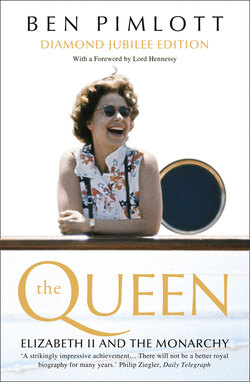Читать книгу The Queen - Peter Hennessy, Ben Pimlott - Страница 9
ОглавлениеFOREWORD
TO THE DIAMOND JUBILEE EDITION
Had Ben Pimlott been with us in the run-up to 2012, the print and electronic media would have made his telephone number and email the first to which they turned for a Diamond Jubilee assessment of the reign of Queen Elizabeth II. To understand why is captured between these covers. The pages to come are the product of what happened when a leading political biographer and a top-flight historian of the twentieth century, the gifts combined in Ben’s person, took a long and serious look at the formation, the functions, the style and the adaptability of the lady whom we Brits of the post-war era were, and are, so fortunate to have as our Head of State.
Ben was naturally superb at calibrating the fluidities of our political and constitutional streams as they touched and occasionally refashioned the ancient banks of the Monarchy. He set the Queen’s reign in the context of all the wider changes to her UK realm on her road from 1952 – withdrawal from Empire; the long, reluctant retreat from great powerdom; our emotional deficit with Europe; a social revolution or two; and considerable changes in the size and make-up of our population. Through all these shifts, the Queen has been a gilt-edged constant who, in my judgement, has never put a court shoe wrong as a constitutional sovereign even though as a country we are entirely without a written highway code for Monarchy, relying on conventions and a constitution which, as Mr Gladstone wrote, ‘presumes more boldly than any other the good sense and good faith of those who work it’. Good sense and good faith are the prime requirements of a British and Commonwealth constitutional monarch and the Queen possesses both in abundance.
Ben Pimlott understood all this and illustrated it through all his pages, not one of which was dully written. He also had a sure touch when it came to the emotional geography of the wider landscapes where the Sovereign, the Royal Family and the people meet. He, for example, was the pilot we – and future historians – needed through the days and the swirls and the eddies that followed the death of Princess Diana in 1997. I have a suspicion that it was Ben who gave Alastair Campbell the description ‘the People’s Princess’ which the Prime Minister, Tony Blair, took up in his reaction to the tragedy in Paris. Ben was very good at mapping the Queen’s and the Palace’s recovery from the wobble in public esteem of September 1997. And it’s fascinating to think what Ben might have made now of the sixty-year spectrum of the Queen’s reign – of the self-restoring powers of the British Monarchy and of the enduring qualities of Queen Elizabeth which have always been a lustrous asset in tough times as well as the easier stretches in the life of her nation.
It is always difficult to winnow out the personal premium from the good standing of the institution of Monarchy (there are usually two-thirds of those polled in the United Kingdom in favour of it). The Queen came to the throne at a time when we were dripping with deference as a society. We are scarcely moist now. Yet the esteem for the Queen remains. As Head of State, she has always enhanced the great office she holds. The same cannot be said of others – not least some of those who have held the headship of government as Prime Minister in No. 10 Downing Street. And one scans the world in vain for another sixty-year example of faultless public duty. The Queen could not have had better personal trainers than her father, King George VI, and her mother, Queen Elizabeth. But, in sporting terms, it’s as if she had won gold at every Olympics from Helsinki in 1952 to London in 2012.
Ben Pimlott, too, won gold by writing this book and gold standard it will remain. For I will be surprised if, when the Queen’s official biographer is appointed, it’s not Pimlott on Elizabeth II that’s the first book for which he or she will reach on the shelf.
Lord Hennessy of Nympsfield, FBA
Attlee Professor of Contemporary British History
School of History, Queen Mary, University of London
LondonMarch 2012
